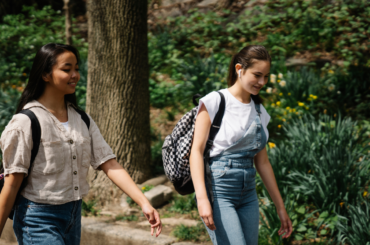Parents who spend any time on social media have probably already seen plenty of content about “stranger danger” and trafficking. While nightmare scenarios like kidnapping and sex trafficking are very real and not out of the realm of possibility, the rumors and myths being spread online may be doing more harm than good.
The world can certainly be a scary place — especially if you’re raising kids — but fixating on potential dangers may only serve to spread fear to your kids, which can actually be harmful to their health and wellbeing. Teaching your children to fear the world can make them less happy, less healthy, and even less tolerant toward others. It can even potentially discourage them from seeking help in an emergency.
Plus, it’s tough to hear but true — many dangers kids face come from people they don’t consider strangers. They could face risks with a neighbor they see every day, a family friend, or someone they think they “know” on the internet, so just teaching them to avoid “strangers” doesn’t entirely cover what they need to know.
So how can parents teach their kids about the very real dangers they might face without scaring them or teaching them to live in fear? This script will provide some specific things parents can say to keep their kids safe without scaring them.
Swap “stranger danger” for “stranger safety”
Knowledge and skills, rather than fear, are the keys to keeping kids safe. Teaching them to be afraid of all strangers can lead to unnecessary anxiety as they move through the world. Instead, explain the rules for how to engage with people they know versus people they don’t know. Here’s what you can say:
“A stranger is anyone you don’t already know. Can you think of some people you know? Now point out someone around us who is a stranger. Most strangers are good, but if a stranger approaches you, you should check with the adult in charge before you talk to them or take anything from them.”
Your child should be familiar with a short list of safe adults who can ask as the adult in charge when the primary caregivers aren’t around. Make sure they know who is in charge of picking them up each day and make the rules clear. For example:
“Your babysitter will pick you up from school each day. If anyone else comes, even someone we know and trust, do not go with them until you have called me and I’ve said it’s OK.”
Set clear boundaries
Rules on how to engage with strangers versus people they know should be simple and crystal clear for kids. If your child is older and spends any time on their own in public (like at the bus stop) they should have a clear understanding of what to do if a stranger approaches them. Here are some examples of rules and boundaries you might set for your children to keep them safe:
“A good thing to remember is to always ask first — even if it’s someone familiar, like a neighbor, you should make sure it’s OK with me or the grownup in charge before going anywhere or taking anything from them.”
“Remember, the rules are different when you’re with an adult who is taking care of you and when you’re on your own. Never share personal information with a stranger or anyone who makes you feel uncomfortable. But if an emergency happens, you can ask for help from a stranger. It’s a good idea to look for someone who already has a kid with them.”
Make a safety plan
If an emergency happens or a child gets lost, they should know what to do to keep themselves safe and find help. Run through some basic scenarios with them and remind them that they are unlikely, but knowing what to do ahead of time will keep them safe if anything comes up.
It’s a good idea to regularly check in with them to make sure they remember and understand the safety plan. Ask them the following questions to check their memory and understanding:
“What would you do if a stranger asked you to go somewhere with them?”
“What would you do if we got separated in public?”
“Who is on our list of safe adults?”
“What is our address? What’s my cell phone number?”
Repetition and positive reinforcement are key to driving home these important safety rules for kids. It’s especially helpful to review the rules just before going to a busy public place, an event, or taking a trip. The goal should not be scaring them, but giving them the confidence and skills to stay safe in the unlikely scenario that they find themselves in a risky situation.







